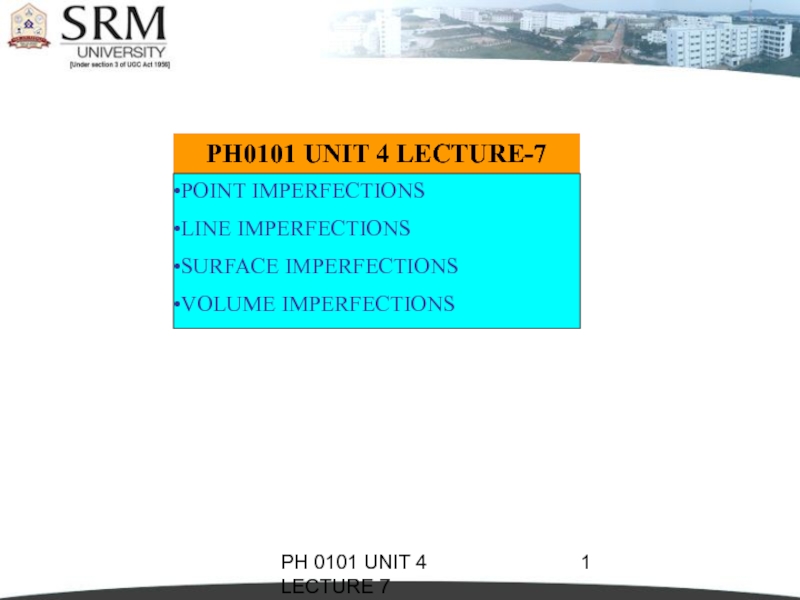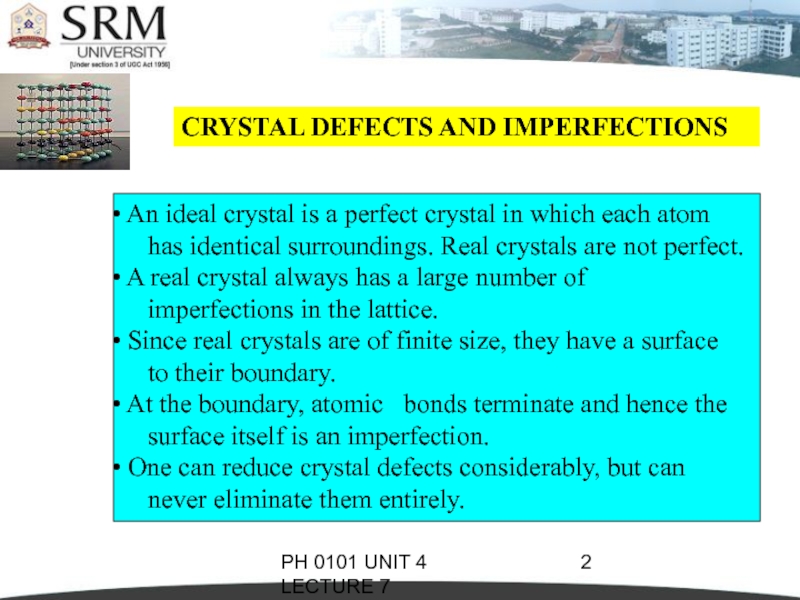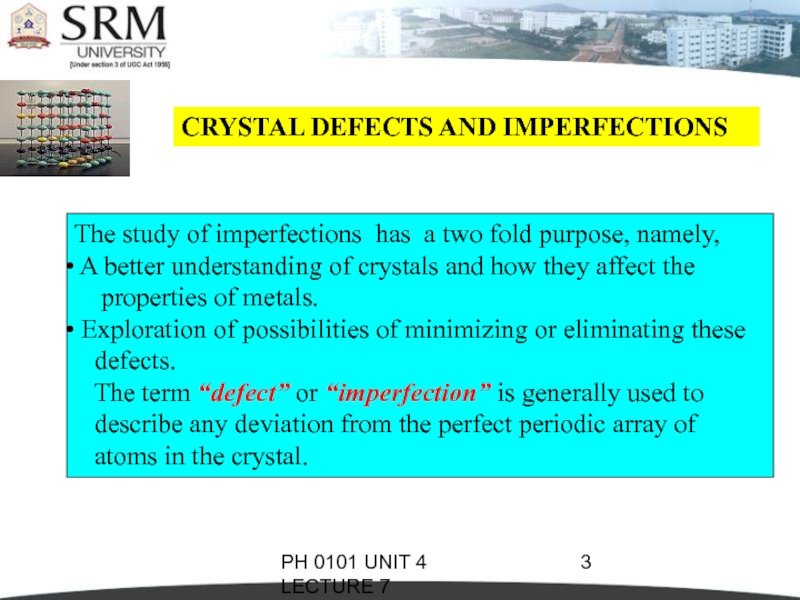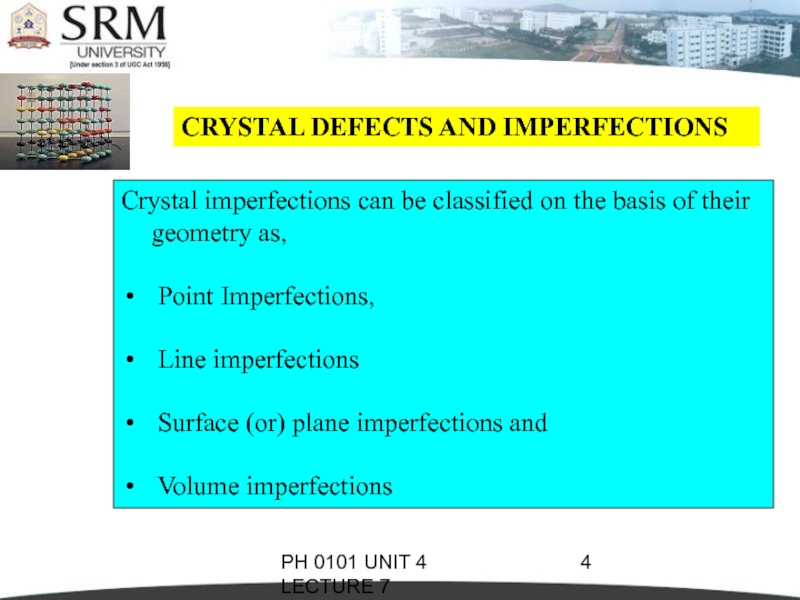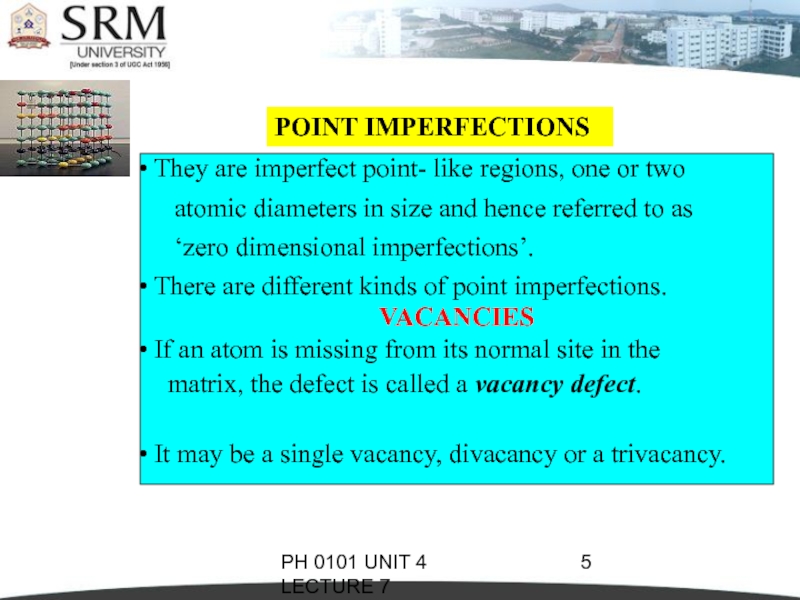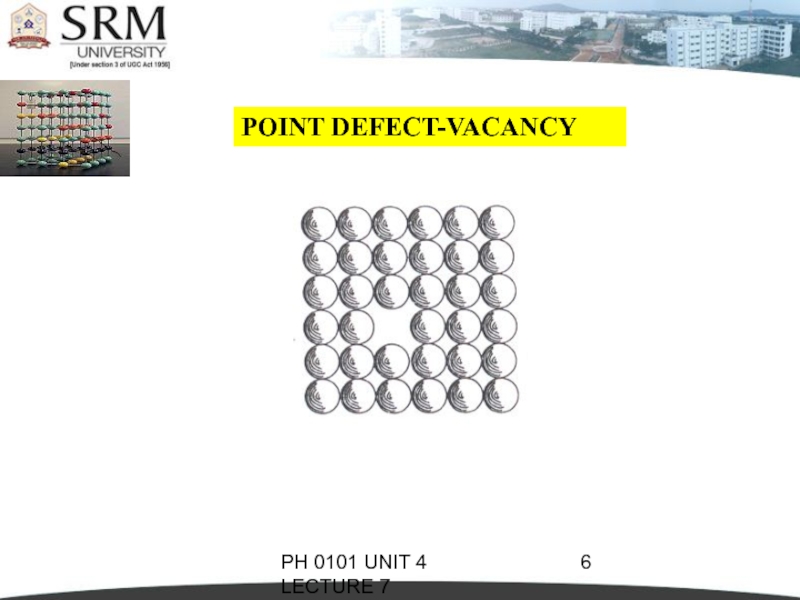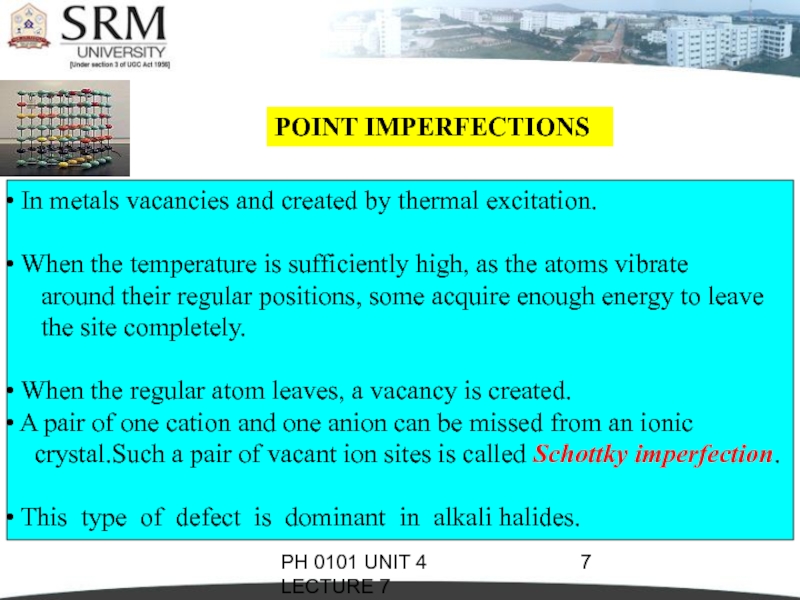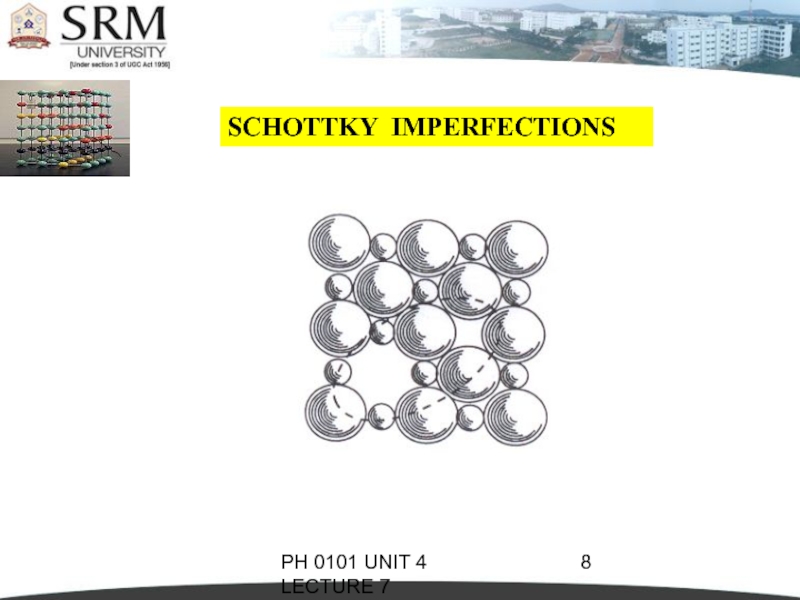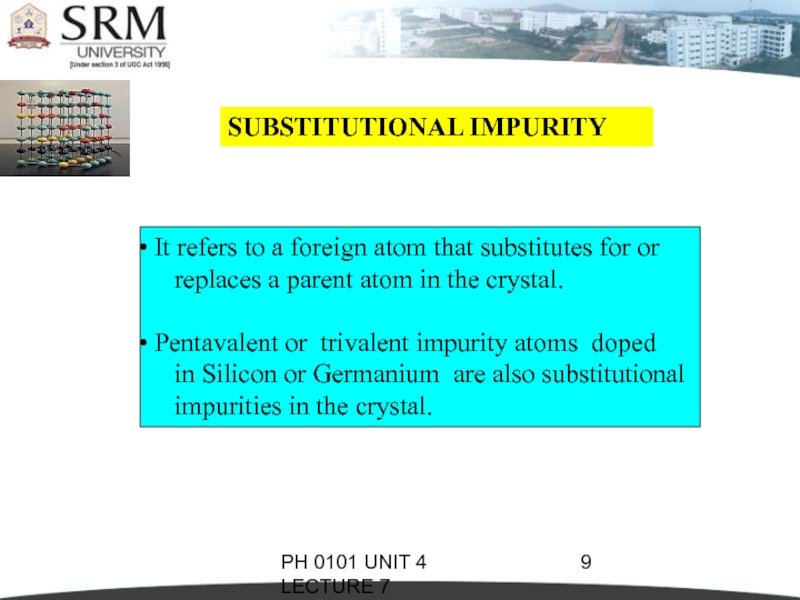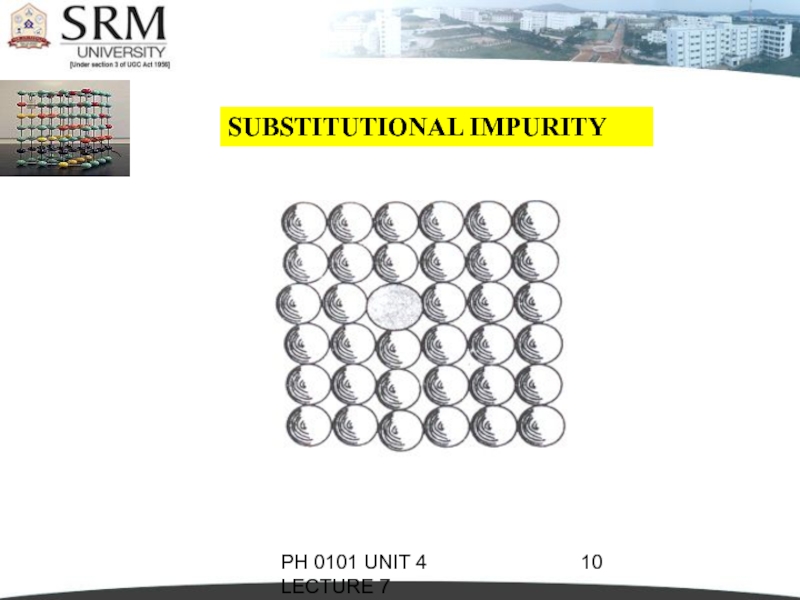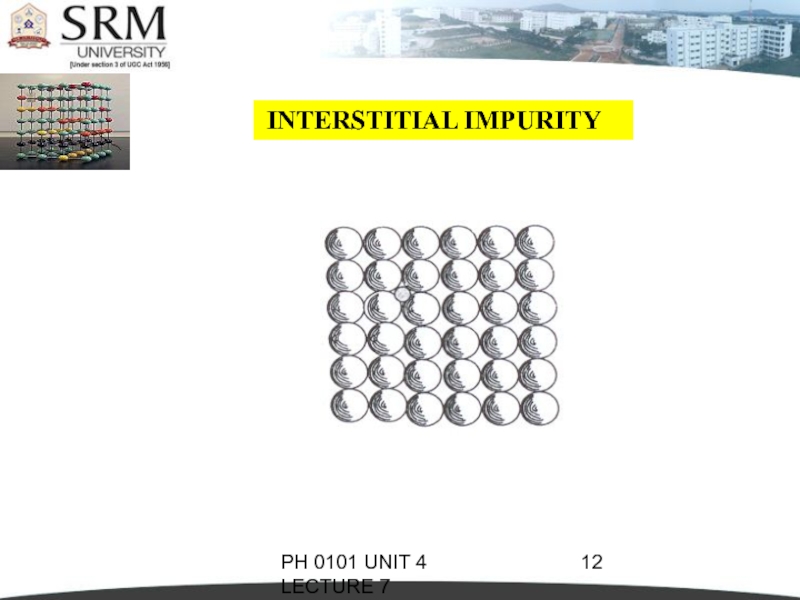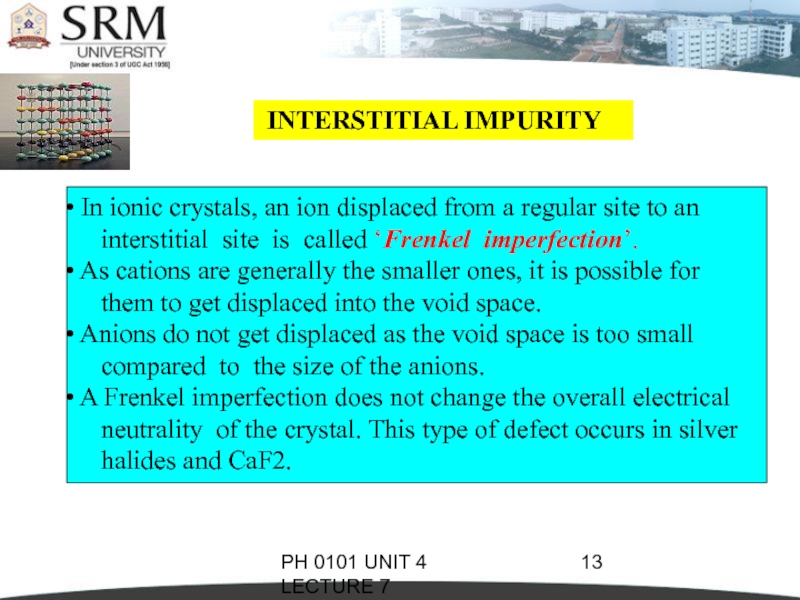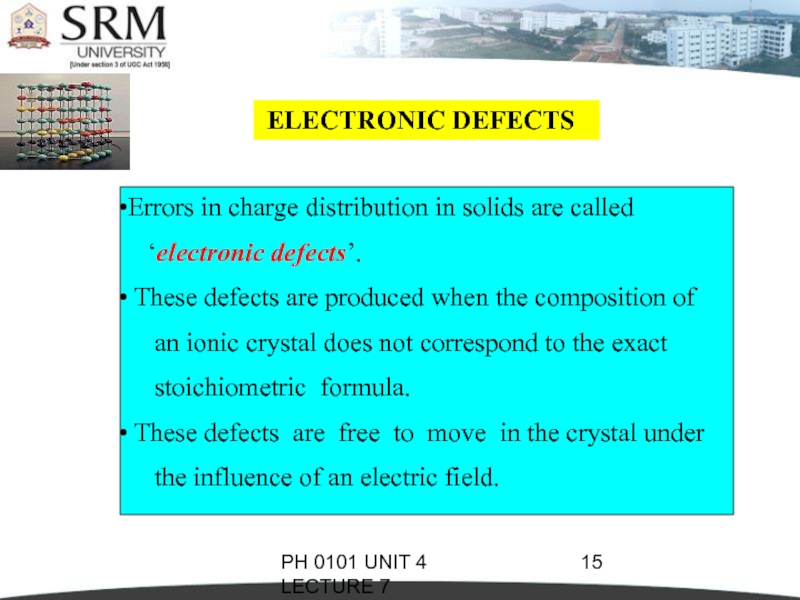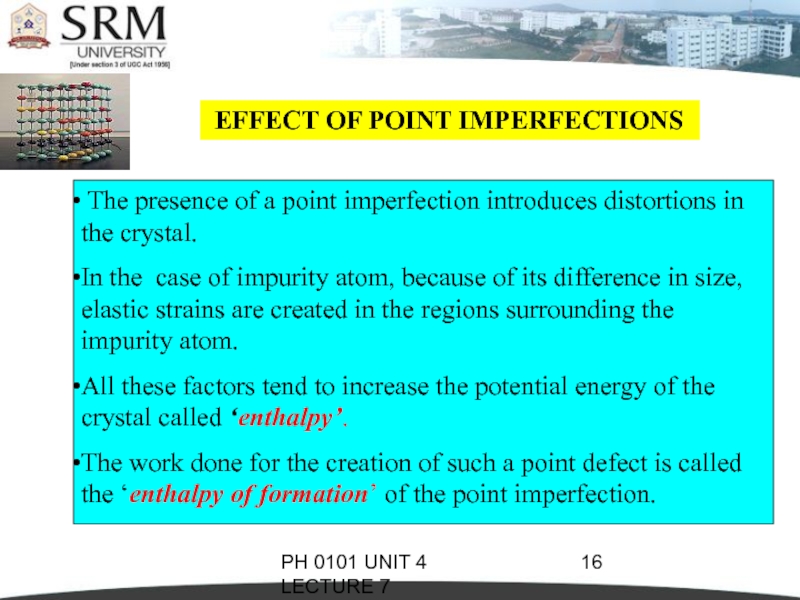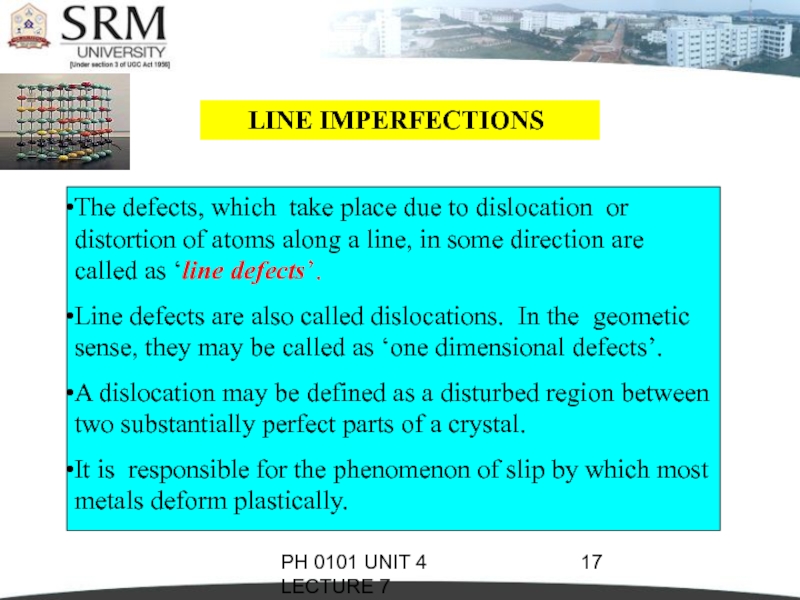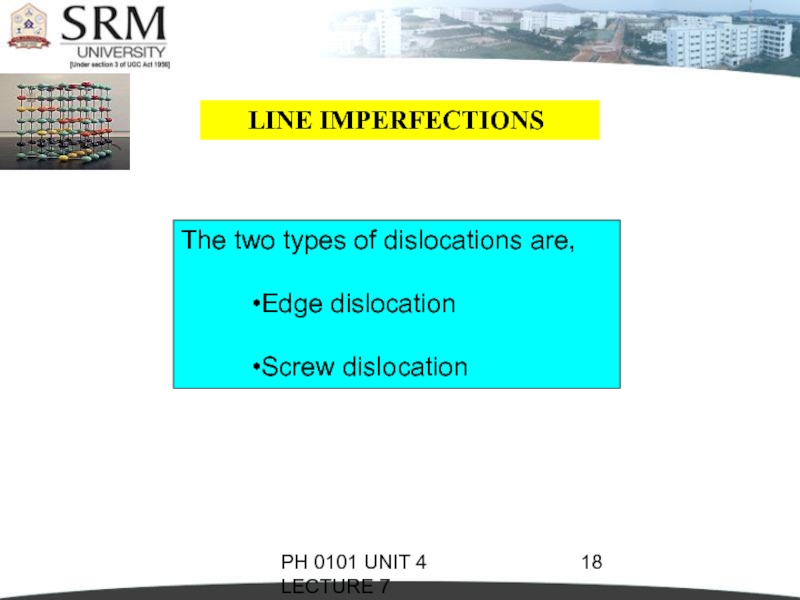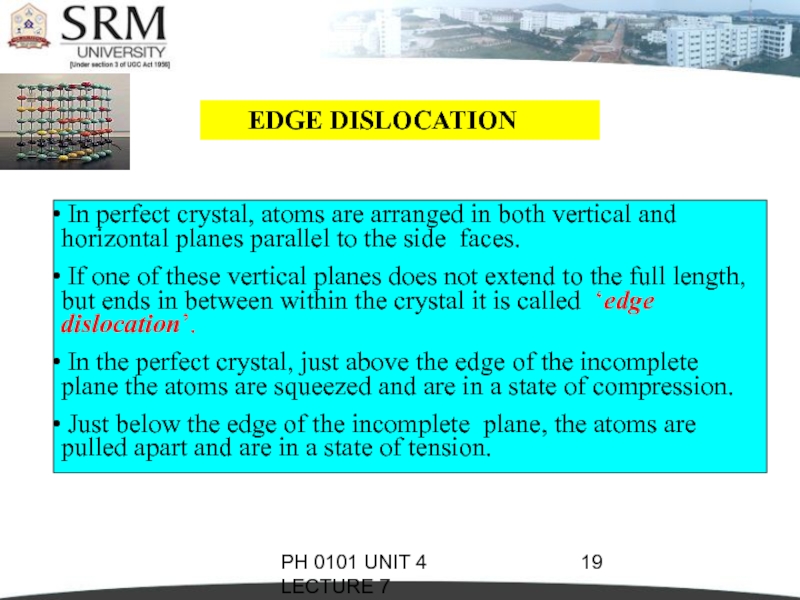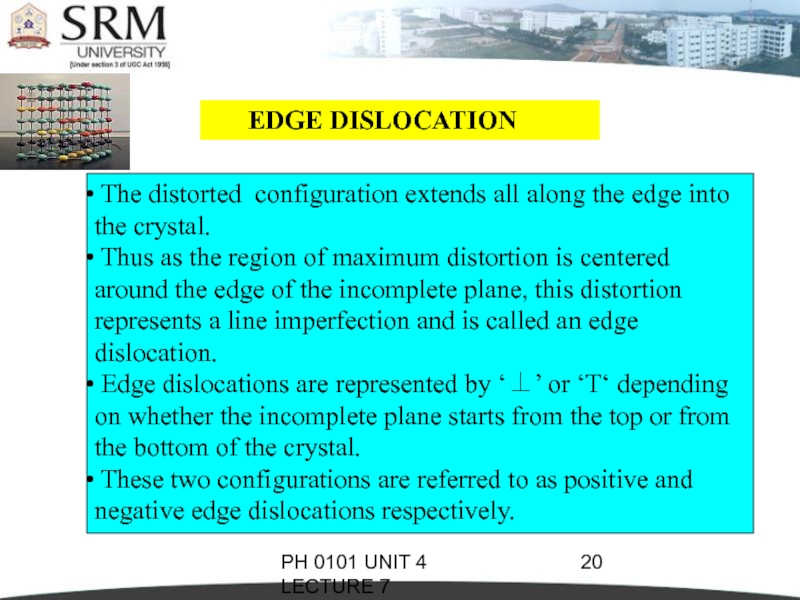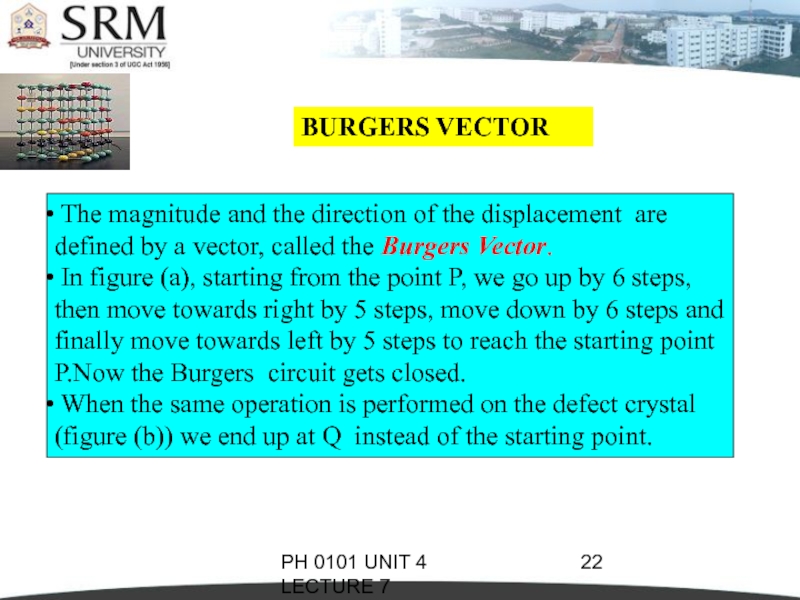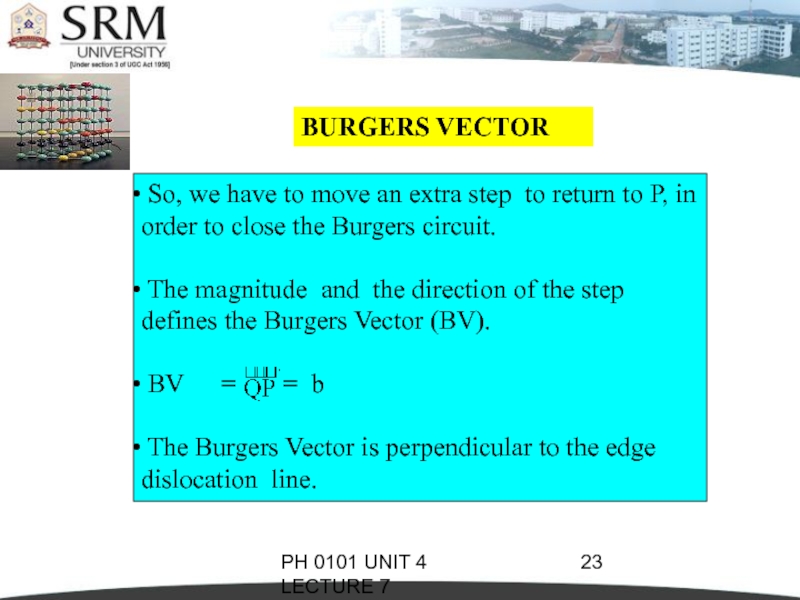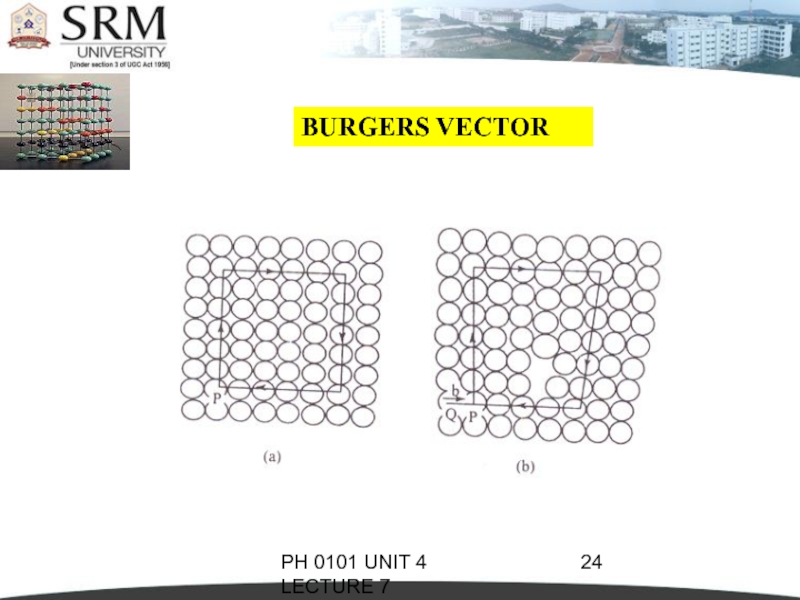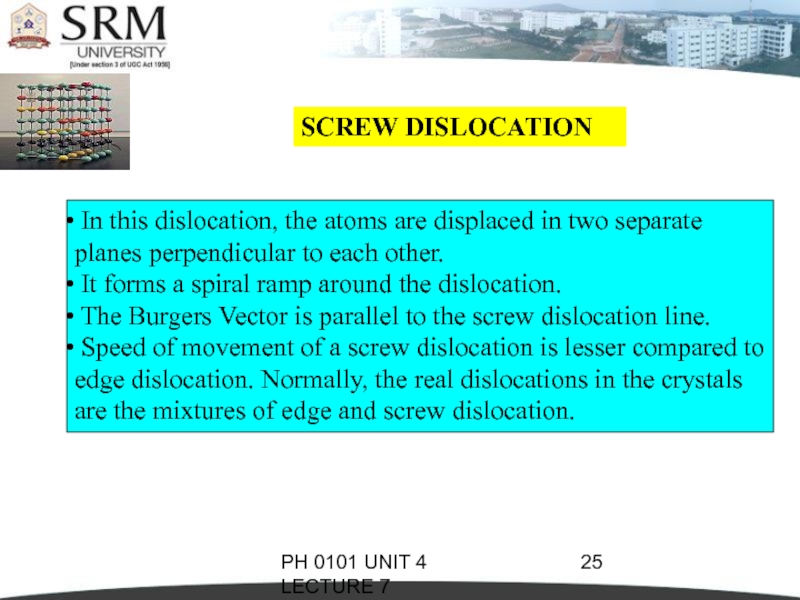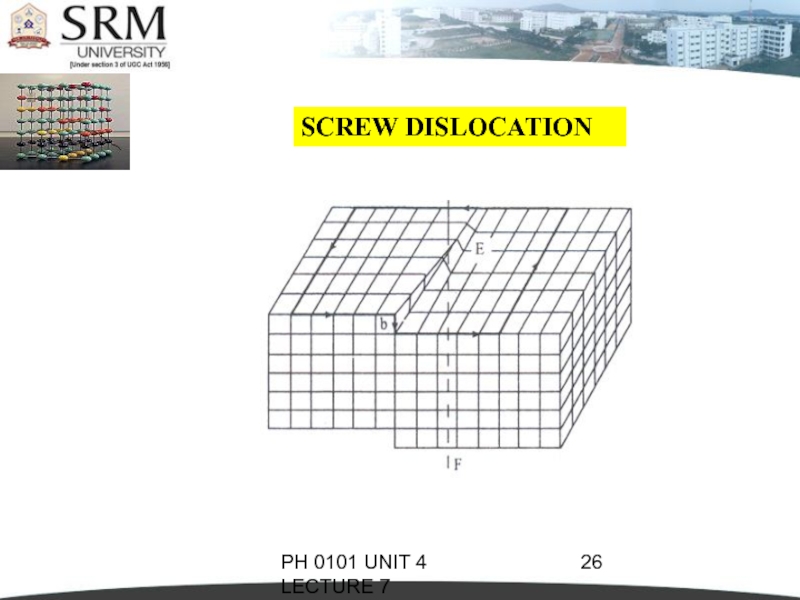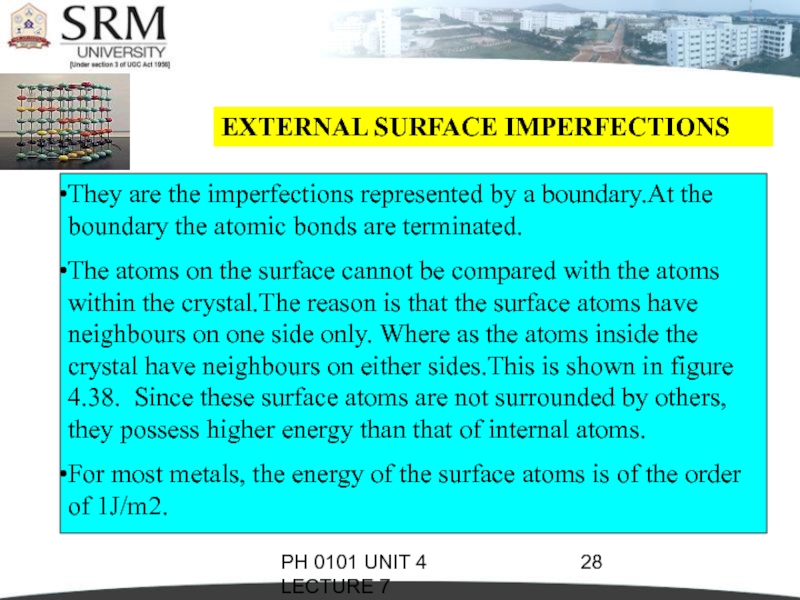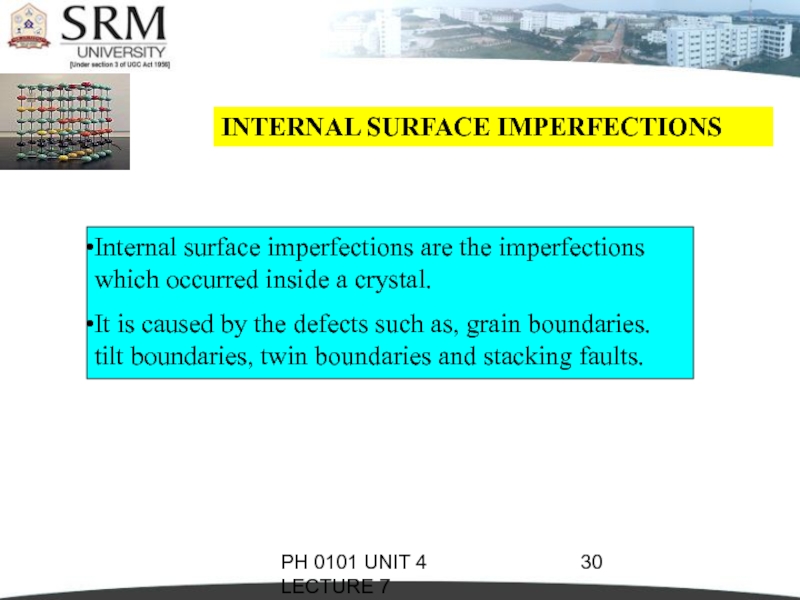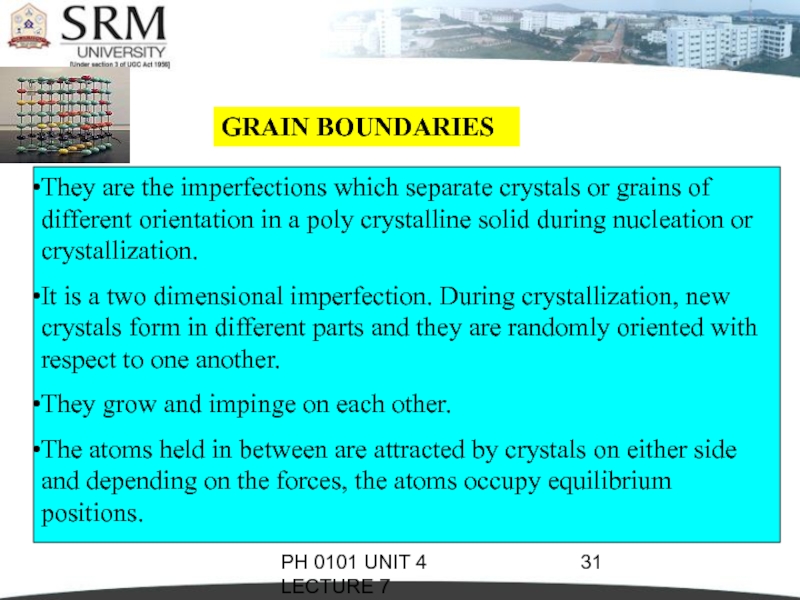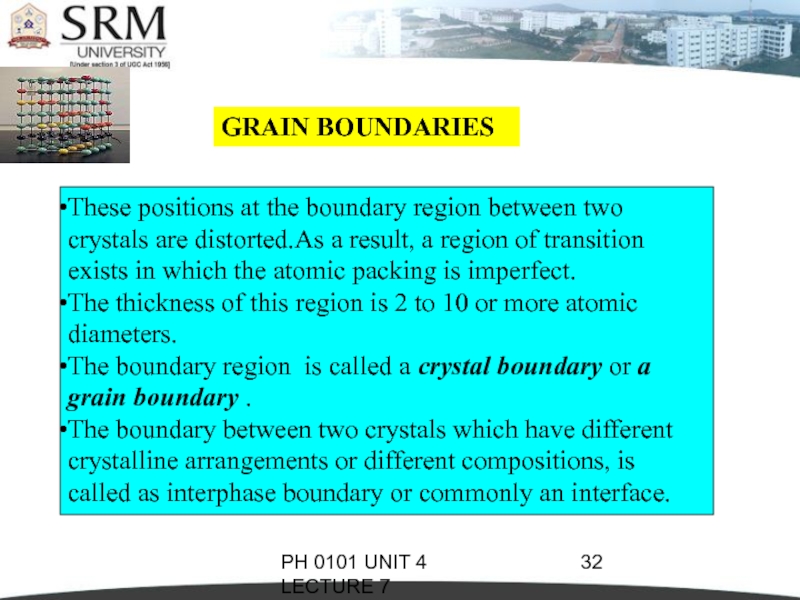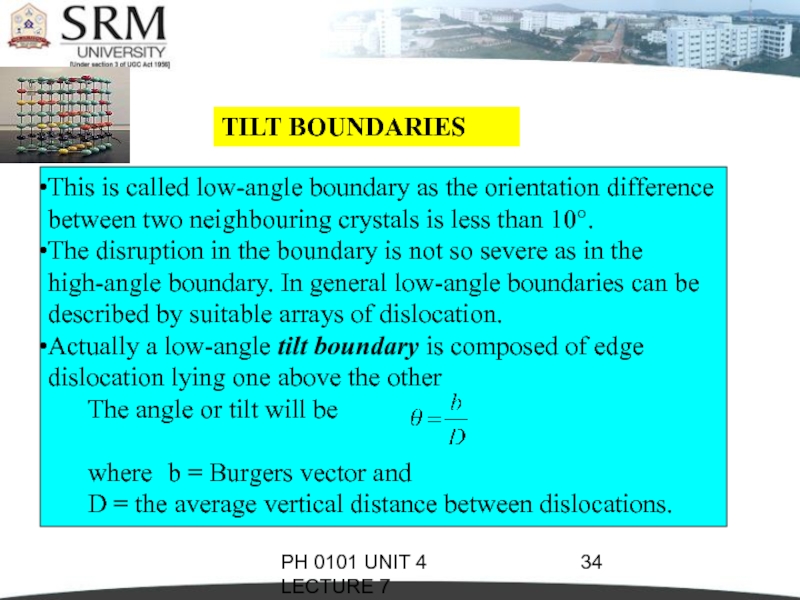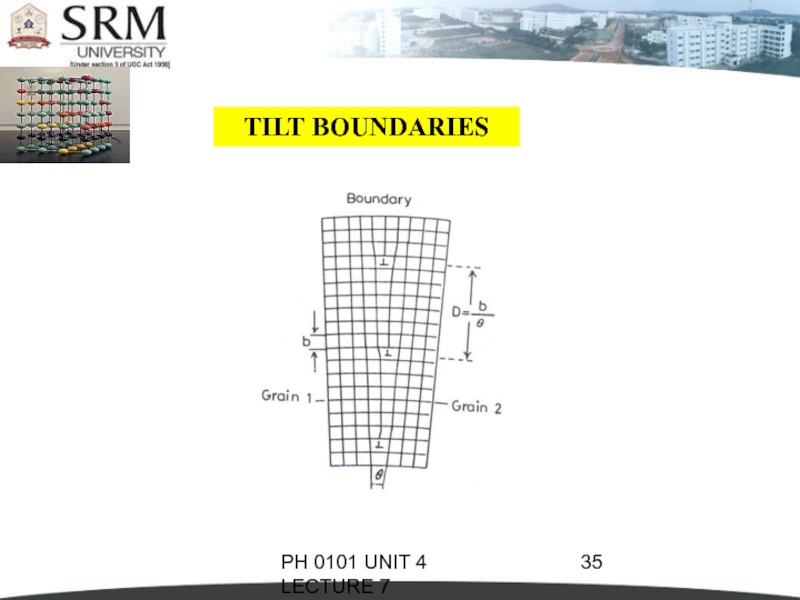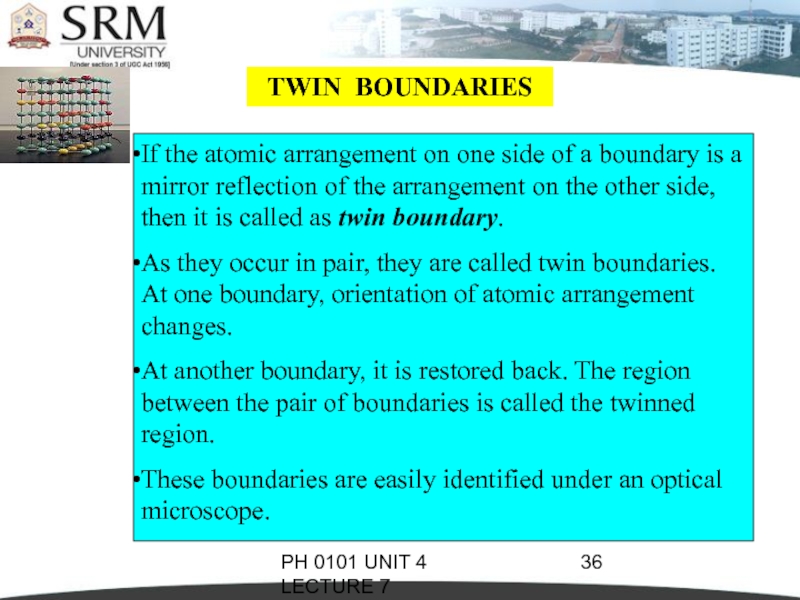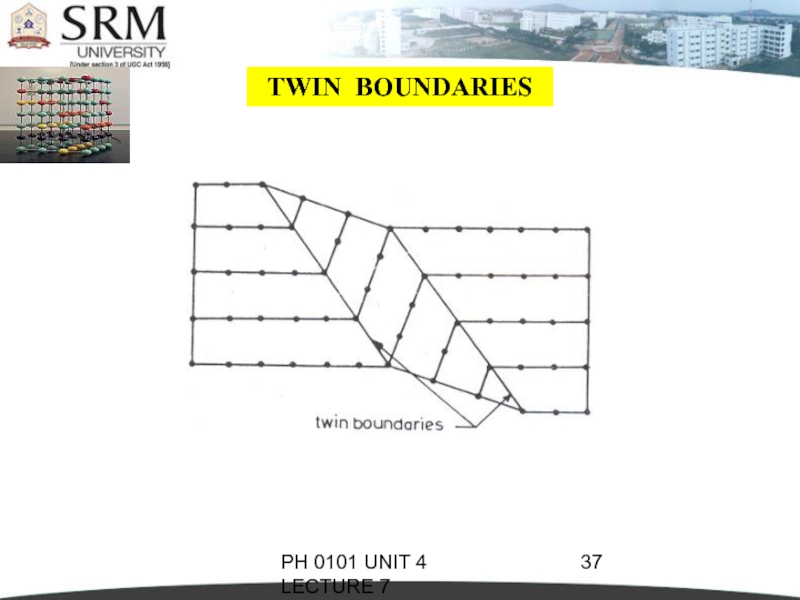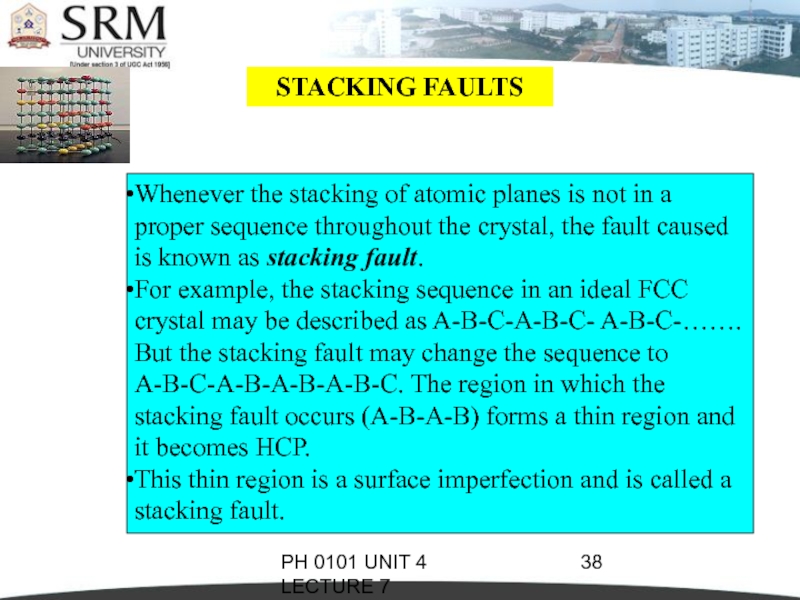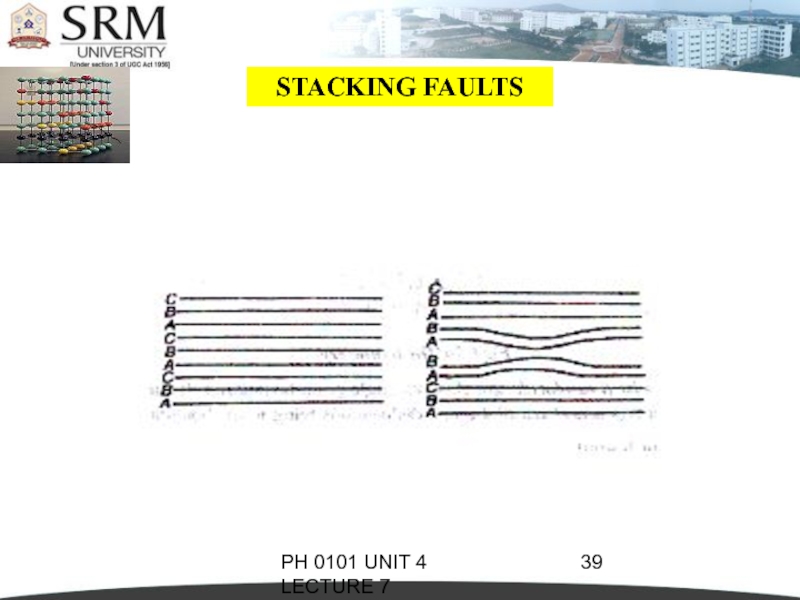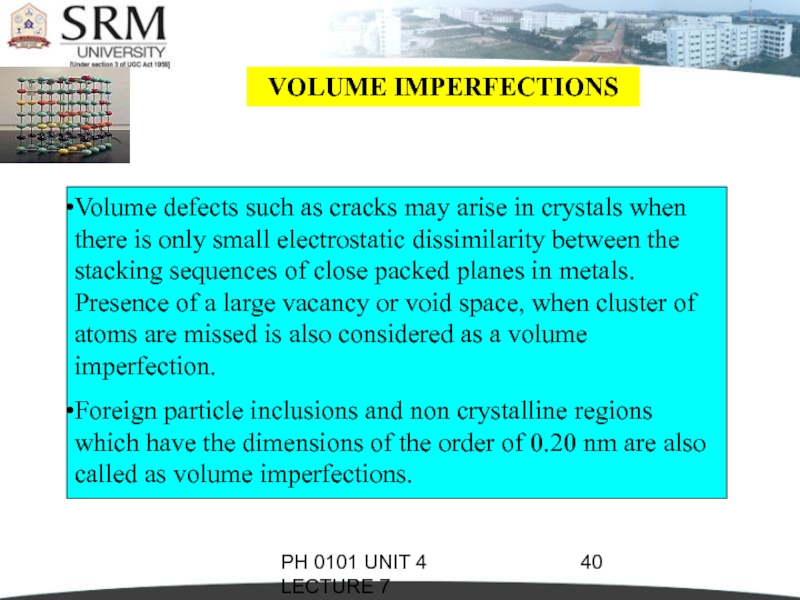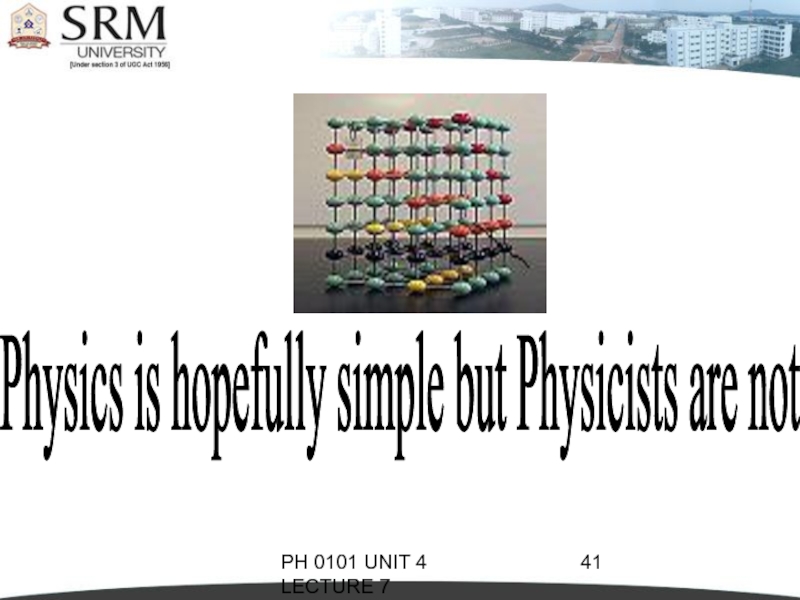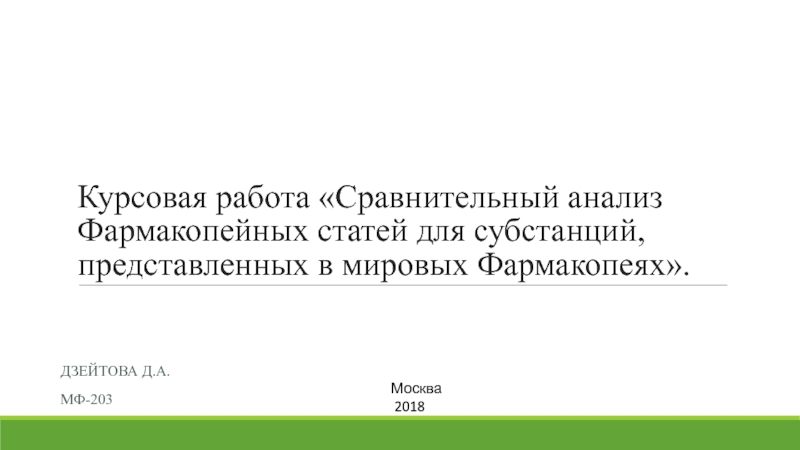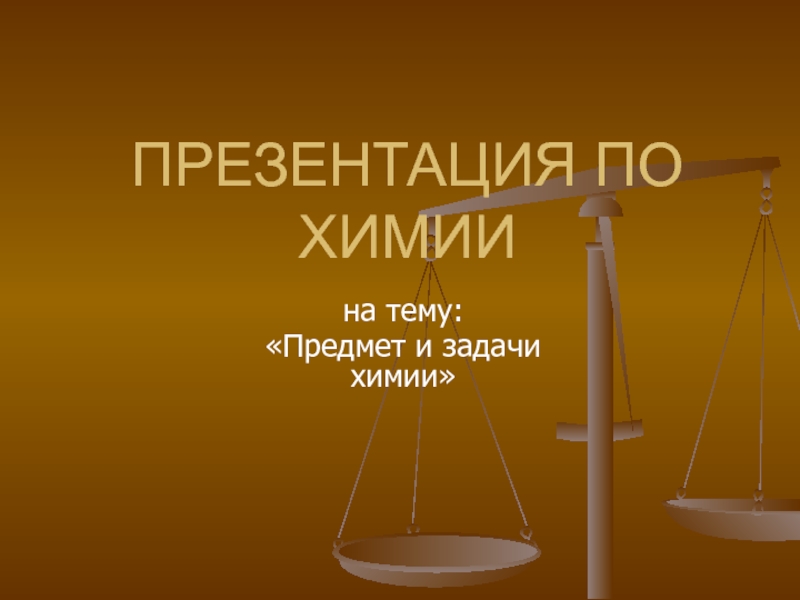IMPERFECTIONS
VOLUME IMPERFECTIONS
- Главная
- Разное
- Дизайн
- Бизнес и предпринимательство
- Аналитика
- Образование
- Развлечения
- Красота и здоровье
- Финансы
- Государство
- Путешествия
- Спорт
- Недвижимость
- Армия
- Графика
- Культурология
- Еда и кулинария
- Лингвистика
- Английский язык
- Астрономия
- Алгебра
- Биология
- География
- Детские презентации
- Информатика
- История
- Литература
- Маркетинг
- Математика
- Медицина
- Менеджмент
- Музыка
- МХК
- Немецкий язык
- ОБЖ
- Обществознание
- Окружающий мир
- Педагогика
- Русский язык
- Технология
- Физика
- Философия
- Химия
- Шаблоны, картинки для презентаций
- Экология
- Экономика
- Юриспруденция
Crystal defects and imperfections презентация
Содержание
- 1. Crystal defects and imperfections
- 2. PH 0101 UNIT 4 LECTURE 7 CRYSTAL
- 3. PH 0101 UNIT 4 LECTURE 7 CRYSTAL
- 4. PH 0101 UNIT 4 LECTURE 7 CRYSTAL
- 5. PH 0101 UNIT 4 LECTURE 7 POINT
- 6. PH 0101 UNIT 4 LECTURE 7 POINT DEFECT-VACANCY
- 7. PH 0101 UNIT 4 LECTURE 7 POINT
- 8. PH 0101 UNIT 4 LECTURE 7 SCHOTTKY IMPERFECTIONS
- 9. PH 0101 UNIT 4 LECTURE 7 SUBSTITUTIONAL
- 10. PH 0101 UNIT 4 LECTURE 7 SUBSTITUTIONAL IMPURITY
- 11. PH 0101 UNIT 4 LECTURE 7
- 12. PH 0101 UNIT 4 LECTURE 7 INTERSTITIAL IMPURITY
- 13. PH 0101 UNIT 4 LECTURE 7
- 14. PH 0101 UNIT 4 LECTURE 7 DIAGRAM SHOWING THE IMPERFECTIONS
- 15. PH 0101 UNIT 4 LECTURE 7
- 16. PH 0101 UNIT 4 LECTURE 7
- 17. PH 0101 UNIT 4 LECTURE 7
- 18. PH 0101 UNIT 4 LECTURE 7
- 19. PH 0101 UNIT 4 LECTURE 7
- 20. PH 0101 UNIT 4 LECTURE 7
- 21. PH 0101 UNIT 4 LECTURE 7 EDGE DISLOCATION
- 22. PH 0101 UNIT 4 LECTURE 7 BURGERS
- 23. PH 0101 UNIT 4 LECTURE 7 BURGERS
- 24. PH 0101 UNIT 4 LECTURE 7 BURGERS VECTOR
- 25. PH 0101 UNIT 4 LECTURE 7 SCREW
- 26. PH 0101 UNIT 4 LECTURE 7 SCREW DISLOCATION
- 27. PH 0101 UNIT 4 LECTURE 7 SURFACE
- 28. PH 0101 UNIT 4 LECTURE 7 EXTERNAL
- 29. PH 0101 UNIT 4 LECTURE 7 EXTERNAL SURFACE IMPERFECTIONS
- 30. PH 0101 UNIT 4 LECTURE 7 INTERNAL
- 31. PH 0101 UNIT 4 LECTURE 7 GRAIN
- 32. PH 0101 UNIT 4 LECTURE 7 GRAIN
- 33. PH 0101 UNIT 4 LECTURE 7 GRAIN BOUNDARIES
- 34. PH 0101 UNIT 4 LECTURE 7 TILT
- 35. PH 0101 UNIT 4 LECTURE 7 TILT BOUNDARIES
- 36. PH 0101 UNIT 4 LECTURE 7 TWIN
- 37. PH 0101 UNIT 4 LECTURE 7 TWIN BOUNDARIES
- 38. PH 0101 UNIT 4 LECTURE 7 STACKING
- 39. PH 0101 UNIT 4 LECTURE 7 STACKING FAULTS
- 40. PH 0101 UNIT 4 LECTURE 7 VOLUME
- 41. PH 0101 UNIT 4 LECTURE 7 Physics is hopefully simple but Physicists are not
Слайд 2PH 0101 UNIT 4 LECTURE 7
CRYSTAL DEFECTS AND IMPERFECTIONS
An ideal
crystal is a perfect crystal in which each atom
has identical surroundings. Real crystals are not perfect.
A real crystal always has a large number of
imperfections in the lattice.
Since real crystals are of finite size, they have a surface
to their boundary.
At the boundary, atomic bonds terminate and hence the
surface itself is an imperfection.
One can reduce crystal defects considerably, but can
never eliminate them entirely.
has identical surroundings. Real crystals are not perfect.
A real crystal always has a large number of
imperfections in the lattice.
Since real crystals are of finite size, they have a surface
to their boundary.
At the boundary, atomic bonds terminate and hence the
surface itself is an imperfection.
One can reduce crystal defects considerably, but can
never eliminate them entirely.
Слайд 3PH 0101 UNIT 4 LECTURE 7
CRYSTAL DEFECTS AND IMPERFECTIONS
The study of
imperfections has a two fold purpose, namely,
A better understanding of crystals and how they affect the
properties of metals.
Exploration of possibilities of minimizing or eliminating these
defects.
The term “defect” or “imperfection” is generally used to
describe any deviation from the perfect periodic array of
atoms in the crystal.
A better understanding of crystals and how they affect the
properties of metals.
Exploration of possibilities of minimizing or eliminating these
defects.
The term “defect” or “imperfection” is generally used to
describe any deviation from the perfect periodic array of
atoms in the crystal.
Слайд 4PH 0101 UNIT 4 LECTURE 7
CRYSTAL DEFECTS AND IMPERFECTIONS
Crystal imperfections can
be classified on the basis of their geometry as,
Point Imperfections,
Line imperfections
Surface (or) plane imperfections and
Volume imperfections
Point Imperfections,
Line imperfections
Surface (or) plane imperfections and
Volume imperfections
Слайд 5PH 0101 UNIT 4 LECTURE 7
POINT IMPERFECTIONS
They are imperfect point-
like regions, one or two
atomic diameters in size and hence referred to as
‘zero dimensional imperfections’.
There are different kinds of point imperfections.
VACANCIES
If an atom is missing from its normal site in the
matrix, the defect is called a vacancy defect.
It may be a single vacancy, divacancy or a trivacancy.
atomic diameters in size and hence referred to as
‘zero dimensional imperfections’.
There are different kinds of point imperfections.
VACANCIES
If an atom is missing from its normal site in the
matrix, the defect is called a vacancy defect.
It may be a single vacancy, divacancy or a trivacancy.
Слайд 7PH 0101 UNIT 4 LECTURE 7
POINT IMPERFECTIONS
In metals vacancies and
created by thermal excitation.
When the temperature is sufficiently high, as the atoms vibrate
around their regular positions, some acquire enough energy to leave
the site completely.
When the regular atom leaves, a vacancy is created.
A pair of one cation and one anion can be missed from an ionic
crystal.Such a pair of vacant ion sites is called Schottky imperfection.
This type of defect is dominant in alkali halides.
When the temperature is sufficiently high, as the atoms vibrate
around their regular positions, some acquire enough energy to leave
the site completely.
When the regular atom leaves, a vacancy is created.
A pair of one cation and one anion can be missed from an ionic
crystal.Such a pair of vacant ion sites is called Schottky imperfection.
This type of defect is dominant in alkali halides.
Слайд 9PH 0101 UNIT 4 LECTURE 7
SUBSTITUTIONAL IMPURITY
It refers to
a foreign atom that substitutes for or
replaces a parent atom in the crystal.
Pentavalent or trivalent impurity atoms doped
in Silicon or Germanium are also substitutional
impurities in the crystal.
replaces a parent atom in the crystal.
Pentavalent or trivalent impurity atoms doped
in Silicon or Germanium are also substitutional
impurities in the crystal.
Слайд 11PH 0101 UNIT 4 LECTURE 7
INTERSTITIAL IMPURITY
An interstitial
defect arises when an atom occupies a
definite position in the lattice that is not normally occupied
in the perfect crystal.
In crystals, packing density is always less than 1.
If a small sized atom occupies the void space in the parent
crystal without disturbing the parent atoms from their
regular sites, then it is called as ‘interstitial impurity’.
definite position in the lattice that is not normally occupied
in the perfect crystal.
In crystals, packing density is always less than 1.
If a small sized atom occupies the void space in the parent
crystal without disturbing the parent atoms from their
regular sites, then it is called as ‘interstitial impurity’.
Слайд 13PH 0101 UNIT 4 LECTURE 7
INTERSTITIAL IMPURITY
In ionic
crystals, an ion displaced from a regular site to an
interstitial site is called ‘Frenkel imperfection’.
As cations are generally the smaller ones, it is possible for
them to get displaced into the void space.
Anions do not get displaced as the void space is too small
compared to the size of the anions.
A Frenkel imperfection does not change the overall electrical
neutrality of the crystal. This type of defect occurs in silver
halides and CaF2.
interstitial site is called ‘Frenkel imperfection’.
As cations are generally the smaller ones, it is possible for
them to get displaced into the void space.
Anions do not get displaced as the void space is too small
compared to the size of the anions.
A Frenkel imperfection does not change the overall electrical
neutrality of the crystal. This type of defect occurs in silver
halides and CaF2.
Слайд 15PH 0101 UNIT 4 LECTURE 7
ELECTRONIC DEFECTS
Errors in charge
distribution in solids are called
‘electronic defects’.
These defects are produced when the composition of
an ionic crystal does not correspond to the exact
stoichiometric formula.
These defects are free to move in the crystal under
the influence of an electric field.
‘electronic defects’.
These defects are produced when the composition of
an ionic crystal does not correspond to the exact
stoichiometric formula.
These defects are free to move in the crystal under
the influence of an electric field.
Слайд 16PH 0101 UNIT 4 LECTURE 7
EFFECT OF POINT IMPERFECTIONS
The presence of a point imperfection introduces distortions in the crystal.
In the case of impurity atom, because of its difference in size, elastic strains are created in the regions surrounding the impurity atom.
All these factors tend to increase the potential energy of the crystal called ‘enthalpy’.
The work done for the creation of such a point defect is called the ‘enthalpy of formation’ of the point imperfection.
In the case of impurity atom, because of its difference in size, elastic strains are created in the regions surrounding the impurity atom.
All these factors tend to increase the potential energy of the crystal called ‘enthalpy’.
The work done for the creation of such a point defect is called the ‘enthalpy of formation’ of the point imperfection.
Слайд 17PH 0101 UNIT 4 LECTURE 7
LINE IMPERFECTIONS
The
defects, which take place due to dislocation or distortion of atoms along a line, in some direction are called as ‘line defects’.
Line defects are also called dislocations. In the geometic sense, they may be called as ‘one dimensional defects’.
A dislocation may be defined as a disturbed region between two substantially perfect parts of a crystal.
It is responsible for the phenomenon of slip by which most metals deform plastically.
Line defects are also called dislocations. In the geometic sense, they may be called as ‘one dimensional defects’.
A dislocation may be defined as a disturbed region between two substantially perfect parts of a crystal.
It is responsible for the phenomenon of slip by which most metals deform plastically.
Слайд 18PH 0101 UNIT 4 LECTURE 7
LINE IMPERFECTIONS
The
two types of dislocations are,
Edge dislocation
Screw dislocation
Edge dislocation
Screw dislocation
Слайд 19PH 0101 UNIT 4 LECTURE 7
EDGE DISLOCATION
In
perfect crystal, atoms are arranged in both vertical and horizontal planes parallel to the side faces.
If one of these vertical planes does not extend to the full length, but ends in between within the crystal it is called ‘edge dislocation’.
In the perfect crystal, just above the edge of the incomplete plane the atoms are squeezed and are in a state of compression.
Just below the edge of the incomplete plane, the atoms are pulled apart and are in a state of tension.
If one of these vertical planes does not extend to the full length, but ends in between within the crystal it is called ‘edge dislocation’.
In the perfect crystal, just above the edge of the incomplete plane the atoms are squeezed and are in a state of compression.
Just below the edge of the incomplete plane, the atoms are pulled apart and are in a state of tension.
Слайд 20PH 0101 UNIT 4 LECTURE 7
The distorted configuration extends all
along the edge into the crystal.
Thus as the region of maximum distortion is centered around the edge of the incomplete plane, this distortion represents a line imperfection and is called an edge dislocation.
Edge dislocations are represented by ‘⊥’ or ‘Τ‘ depending on whether the incomplete plane starts from the top or from the bottom of the crystal.
These two configurations are referred to as positive and negative edge dislocations respectively.
Thus as the region of maximum distortion is centered around the edge of the incomplete plane, this distortion represents a line imperfection and is called an edge dislocation.
Edge dislocations are represented by ‘⊥’ or ‘Τ‘ depending on whether the incomplete plane starts from the top or from the bottom of the crystal.
These two configurations are referred to as positive and negative edge dislocations respectively.
EDGE DISLOCATION
Слайд 22PH 0101 UNIT 4 LECTURE 7
BURGERS VECTOR
The magnitude and the
direction of the displacement are defined by a vector, called the Burgers Vector.
In figure (a), starting from the point P, we go up by 6 steps, then move towards right by 5 steps, move down by 6 steps and finally move towards left by 5 steps to reach the starting point P.Now the Burgers circuit gets closed.
When the same operation is performed on the defect crystal (figure (b)) we end up at Q instead of the starting point.
In figure (a), starting from the point P, we go up by 6 steps, then move towards right by 5 steps, move down by 6 steps and finally move towards left by 5 steps to reach the starting point P.Now the Burgers circuit gets closed.
When the same operation is performed on the defect crystal (figure (b)) we end up at Q instead of the starting point.
Слайд 23PH 0101 UNIT 4 LECTURE 7
BURGERS VECTOR
So, we have to
move an extra step to return to P, in order to close the Burgers circuit.
The magnitude and the direction of the step defines the Burgers Vector (BV).
BV = = b
The Burgers Vector is perpendicular to the edge dislocation line.
The magnitude and the direction of the step defines the Burgers Vector (BV).
BV = = b
The Burgers Vector is perpendicular to the edge dislocation line.
Слайд 25PH 0101 UNIT 4 LECTURE 7
SCREW DISLOCATION
In this dislocation, the
atoms are displaced in two separate planes perpendicular to each other.
It forms a spiral ramp around the dislocation.
The Burgers Vector is parallel to the screw dislocation line.
Speed of movement of a screw dislocation is lesser compared to edge dislocation. Normally, the real dislocations in the crystals are the mixtures of edge and screw dislocation.
It forms a spiral ramp around the dislocation.
The Burgers Vector is parallel to the screw dislocation line.
Speed of movement of a screw dislocation is lesser compared to edge dislocation. Normally, the real dislocations in the crystals are the mixtures of edge and screw dislocation.
Слайд 27PH 0101 UNIT 4 LECTURE 7
SURFACE IMPERFECTIONS
Surface imperfections arise from a
change in the stacking of atomic planes on or across a boundary.
The change may be one of the orientations or of the stacking sequence of atomic planes.
In geometric concept, surface imperfections are two- dimensional. They are of two types external and internal surface imperfections.
The change may be one of the orientations or of the stacking sequence of atomic planes.
In geometric concept, surface imperfections are two- dimensional. They are of two types external and internal surface imperfections.
Слайд 28PH 0101 UNIT 4 LECTURE 7
EXTERNAL SURFACE IMPERFECTIONS
They are the imperfections
represented by a boundary.At the boundary the atomic bonds are terminated.
The atoms on the surface cannot be compared with the atoms within the crystal.The reason is that the surface atoms have neighbours on one side only. Where as the atoms inside the crystal have neighbours on either sides.This is shown in figure 4.38. Since these surface atoms are not surrounded by others, they possess higher energy than that of internal atoms.
For most metals, the energy of the surface atoms is of the order of 1J/m2.
The atoms on the surface cannot be compared with the atoms within the crystal.The reason is that the surface atoms have neighbours on one side only. Where as the atoms inside the crystal have neighbours on either sides.This is shown in figure 4.38. Since these surface atoms are not surrounded by others, they possess higher energy than that of internal atoms.
For most metals, the energy of the surface atoms is of the order of 1J/m2.
Слайд 30PH 0101 UNIT 4 LECTURE 7
INTERNAL SURFACE IMPERFECTIONS
Internal surface imperfections are
the imperfections which occurred inside a crystal.
It is caused by the defects such as, grain boundaries. tilt boundaries, twin boundaries and stacking faults.
It is caused by the defects such as, grain boundaries. tilt boundaries, twin boundaries and stacking faults.
Слайд 31PH 0101 UNIT 4 LECTURE 7
GRAIN BOUNDARIES
They are the imperfections which
separate crystals or grains of different orientation in a poly crystalline solid during nucleation or crystallization.
It is a two dimensional imperfection. During crystallization, new crystals form in different parts and they are randomly oriented with respect to one another.
They grow and impinge on each other.
The atoms held in between are attracted by crystals on either side and depending on the forces, the atoms occupy equilibrium positions.
It is a two dimensional imperfection. During crystallization, new crystals form in different parts and they are randomly oriented with respect to one another.
They grow and impinge on each other.
The atoms held in between are attracted by crystals on either side and depending on the forces, the atoms occupy equilibrium positions.
Слайд 32PH 0101 UNIT 4 LECTURE 7
GRAIN BOUNDARIES
These positions at the boundary
region between two crystals are distorted.As a result, a region of transition exists in which the atomic packing is imperfect.
The thickness of this region is 2 to 10 or more atomic diameters.
The boundary region is called a crystal boundary or a grain boundary .
The boundary between two crystals which have different crystalline arrangements or different compositions, is called as interphase boundary or commonly an interface.
The thickness of this region is 2 to 10 or more atomic diameters.
The boundary region is called a crystal boundary or a grain boundary .
The boundary between two crystals which have different crystalline arrangements or different compositions, is called as interphase boundary or commonly an interface.
Слайд 34PH 0101 UNIT 4 LECTURE 7
TILT BOUNDARIES
This is called low-angle boundary
as the orientation difference between two neighbouring crystals is less than 10°.
The disruption in the boundary is not so severe as in the high-angle boundary. In general low-angle boundaries can be described by suitable arrays of dislocation.
Actually a low-angle tilt boundary is composed of edge dislocation lying one above the other
The angle or tilt will be
where b = Burgers vector and
D = the average vertical distance between dislocations.
The disruption in the boundary is not so severe as in the high-angle boundary. In general low-angle boundaries can be described by suitable arrays of dislocation.
Actually a low-angle tilt boundary is composed of edge dislocation lying one above the other
The angle or tilt will be
where b = Burgers vector and
D = the average vertical distance between dislocations.
Слайд 36PH 0101 UNIT 4 LECTURE 7
TWIN BOUNDARIES
If the atomic arrangement on
one side of a boundary is a mirror reflection of the arrangement on the other side, then it is called as twin boundary.
As they occur in pair, they are called twin boundaries. At one boundary, orientation of atomic arrangement changes.
At another boundary, it is restored back. The region between the pair of boundaries is called the twinned region.
These boundaries are easily identified under an optical microscope.
As they occur in pair, they are called twin boundaries. At one boundary, orientation of atomic arrangement changes.
At another boundary, it is restored back. The region between the pair of boundaries is called the twinned region.
These boundaries are easily identified under an optical microscope.
Слайд 38PH 0101 UNIT 4 LECTURE 7
STACKING FAULTS
Whenever the stacking of atomic
planes is not in a proper sequence throughout the crystal, the fault caused is known as stacking fault.
For example, the stacking sequence in an ideal FCC crystal may be described as A-B-C-A-B-C- A-B-C-……. But the stacking fault may change the sequence to A-B-C-A-B-A-B-A-B-C. The region in which the stacking fault occurs (A-B-A-B) forms a thin region and it becomes HCP.
This thin region is a surface imperfection and is called a stacking fault.
For example, the stacking sequence in an ideal FCC crystal may be described as A-B-C-A-B-C- A-B-C-……. But the stacking fault may change the sequence to A-B-C-A-B-A-B-A-B-C. The region in which the stacking fault occurs (A-B-A-B) forms a thin region and it becomes HCP.
This thin region is a surface imperfection and is called a stacking fault.
Слайд 40PH 0101 UNIT 4 LECTURE 7
VOLUME IMPERFECTIONS
Volume defects such as cracks
may arise in crystals when there is only small electrostatic dissimilarity between the stacking sequences of close packed planes in metals. Presence of a large vacancy or void space, when cluster of atoms are missed is also considered as a volume imperfection.
Foreign particle inclusions and non crystalline regions which have the dimensions of the order of 0.20 nm are also called as volume imperfections.
Foreign particle inclusions and non crystalline regions which have the dimensions of the order of 0.20 nm are also called as volume imperfections.
